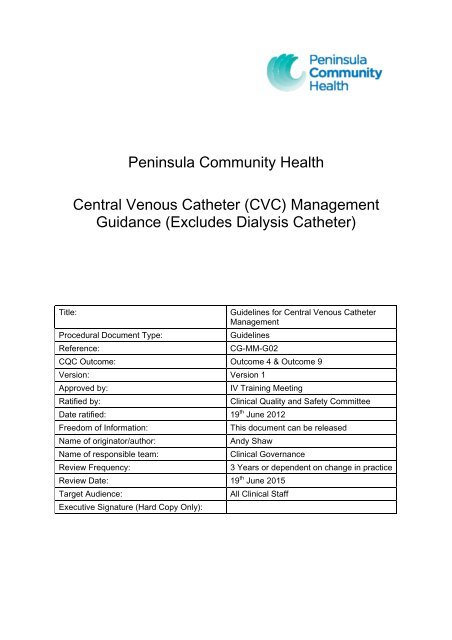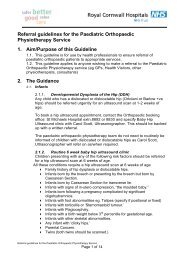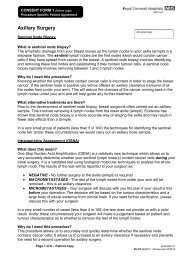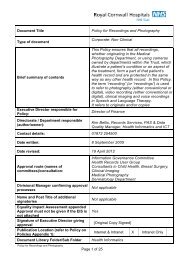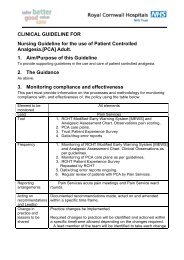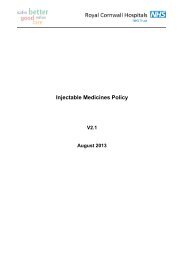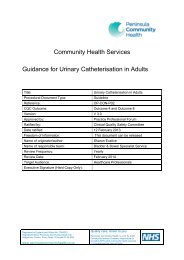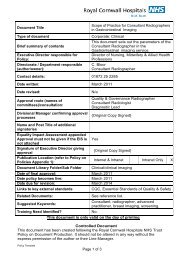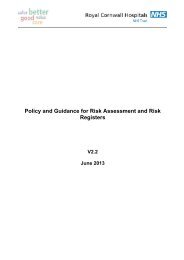(CVC) Management Guidance - the Royal Cornwall Hospitals Trust ...
(CVC) Management Guidance - the Royal Cornwall Hospitals Trust ...
(CVC) Management Guidance - the Royal Cornwall Hospitals Trust ...
Create successful ePaper yourself
Turn your PDF publications into a flip-book with our unique Google optimized e-Paper software.
Peninsula Community Health<br />
Central Venous Ca<strong>the</strong>ter (<strong>CVC</strong>) <strong>Management</strong><br />
<strong>Guidance</strong> (Excludes Dialysis Ca<strong>the</strong>ter)<br />
Title:<br />
Guidelines for Central Venous Ca<strong>the</strong>ter<br />
<strong>Management</strong><br />
Procedural Document Type:<br />
Guidelines<br />
Reference:<br />
CG-MM-G02<br />
CQC Outcome: Outcome 4 & Outcome 9<br />
Version: Version 1<br />
Approved by:<br />
IV Training Meeting<br />
Ratified by:<br />
Clinical Quality and Safety Committee<br />
Date ratified: 19 th June 2012<br />
Freedom of Information:<br />
This document can be released<br />
Name of originator/author:<br />
Andy Shaw<br />
Name of responsible team:<br />
Clinical Governance<br />
Review Frequency:<br />
3 Years or dependent on change in practice<br />
Review Date: 19 th June 2015<br />
Target Audience:<br />
All Clinical Staff<br />
Executive Signature (Hard Copy Only):
Contents<br />
1 Introduction ........................................................................................................ 3<br />
2 Definitions .......................................................................................................... 3<br />
3 Duties................................................................................................................. 3<br />
4 Central Venous Ca<strong>the</strong>ters.................................................................................. 5<br />
5 Indications for a Central Venous Ca<strong>the</strong>ter.......................................................... 5<br />
6 Staff Who Can Manage / Access <strong>CVC</strong>’s ............................................................ 6<br />
7 Insertion of <strong>CVC</strong>’s .............................................................................................. 6<br />
8 Care of Central Venous Ca<strong>the</strong>ters ..................................................................... 6<br />
8.1 Dressings (i.e PICC & Hickman style) (refer to appendix 1)......................... 6<br />
8.2 Flushing <strong>CVC</strong> Lines (Appendix 11 SOP 1, 2, 4)........................................... 7<br />
8.3 Open and closed valve systems: ................................................................. 7<br />
8.4 Locking......................................................................................................... 8<br />
9 Blood Sampling from a Central Venous Ca<strong>the</strong>ter (SOP 3)................................. 8<br />
10 <strong>CVC</strong> problems.................................................................................................... 8<br />
10.1 Occlusions.................................................................................................. 8<br />
11 Removing <strong>CVC</strong>’s................................................................................................ 9<br />
11.1 Indications for Ca<strong>the</strong>ter Removal ............................................................... 9<br />
11.2 PICC line removal ...................................................................................... 9<br />
11.3 Documentation of line removal must include:........................................... 10<br />
12 <strong>CVC</strong> Infections ................................................................................................. 10<br />
12.1 Suspected Insertion Site Infections .......................................................... 10<br />
12.2 Blood Cultures.......................................................................................... 10<br />
13 Education ......................................................................................................... 10<br />
13.1 Staff.......................................................................................................... 10<br />
13.2 Patients .................................................................................................... 11<br />
14 Risk <strong>Management</strong> Strategy Implementation..................................................... 11<br />
14.1 Implementation & Dissemination ........................................................ 11<br />
14.2 Training and Support .......................................................................... 11<br />
14.3 Document Control & Archiving Arrangements .................................... 11<br />
14.4 Equality Impact Assessment............................................................... 12<br />
15 Process for Monitoring Effective Implementation ............................................. 12<br />
16 Associated Documentation............................................................................... 12<br />
17 References....................................................................................................... 12<br />
Please Note <strong>the</strong> Intention of this Document<br />
These guidelines have been developed to ensure that registered staff have correct and clear<br />
guidance with regards to <strong>the</strong> care, maintenance and removal of <strong>the</strong>se lines.<br />
Review and Amendment Log<br />
Version No Type of Change Date Description of change
1 Introduction<br />
As central lines become more common place in <strong>the</strong> Cornish community it has been deemed<br />
essential that registered staff have correct and clear guidance with <strong>the</strong> care, maintenance<br />
and removal of <strong>the</strong>se lines regardless from which hospital <strong>the</strong>y originate. <strong>Cornwall</strong> is<br />
serviced by three main District General <strong>Hospitals</strong> (DGH) and <strong>the</strong> central venous ca<strong>the</strong>ter<br />
(<strong>CVC</strong>) policies/guidelines from each have been considered in <strong>the</strong> preparation of this<br />
guideline. In addition to <strong>the</strong> existing DGH policies, guidance from <strong>the</strong> <strong>Royal</strong> Marsden Manual<br />
for Clinical Nursing Procedure (2011) and EPIC2: National Evidence- Based Guidelines for<br />
Preventing Healthcare-Associated Infections have been used to establish best practice. It is<br />
applicable to all registered practitioners undertaking management of <strong>the</strong>se lines.<br />
2 Definitions<br />
Central Vascular Ca<strong>the</strong>ter (<strong>CVC</strong>): Invasive ca<strong>the</strong>ter inserted into a large vessel ending at<br />
<strong>the</strong> superior vena cava.<br />
Flush: Method of clearing or keeping patent a <strong>CVC</strong><br />
Lock: The amount of solution that is to be kept in <strong>the</strong> length of <strong>the</strong> line in millitres (mLs) after<br />
flushing.<br />
Clamp: A device situated on <strong>the</strong> external part of a <strong>CVC</strong> to close <strong>the</strong> line.<br />
Open system <strong>CVC</strong>: A <strong>CVC</strong> that has no internal non return valve system<br />
Closed system <strong>CVC</strong>: A <strong>CVC</strong> that has an internal device (port) that stops flash back into <strong>the</strong><br />
line. These systems often lack <strong>the</strong> need and <strong>the</strong>refore a clamp.<br />
MVTR: Moisture Vapour Transmission rate. Term applied to occlusive transparent dressings<br />
to denote <strong>the</strong> amount of moisture that can move away from <strong>the</strong> wound/entry site reducing<br />
bacterial build up.<br />
CCAT: Central Ca<strong>the</strong>ter Assessment Tool used by Derriford Hospital (PHNT) to assess<br />
central lines for possible infection (similar to VIP).<br />
Clave: Proximal end ca<strong>the</strong>ter device to help maintain closed sterile system. Has septum and<br />
luer attachment for accepting syringes.<br />
Vacutainer: A device that allows a blood bottle to be inserted to obtain blood from<br />
lines/needles.<br />
VIP score: Visual Infusion Phlebitis score used to assess whe<strong>the</strong>r a <strong>CVC</strong> or peripheral<br />
invasive line is causing phlebitis.<br />
3 Duties<br />
The Director of Nursing and Professional Practice is ultimately responsible for <strong>the</strong><br />
content of this policy and it’s implementation.<br />
PCH Directors are responsible for <strong>the</strong> implementation of this policy across all clinical<br />
services. The policy when ratified will be posted on <strong>the</strong> intranet.
Individual Matrons, Clinical Managers, Professional and Clinical Leads are responsible<br />
for ensuring staff are working to <strong>the</strong> guidance of <strong>the</strong> policy and monitoring its<br />
implementation.<br />
Clinical staff are responsible for ensuring <strong>the</strong>y work within <strong>the</strong> guidance of <strong>the</strong> policy.<br />
Peninsula Community Health are responsible in partnership with <strong>the</strong> medical physics<br />
teams to ensure that all intravenous pumps are appropriately serviced annually and an audit<br />
trail is available.<br />
Peninsula Community Health are responsible for providing and ensuring that all staff using<br />
medical devices are appropriately trained (MDA 2006).<br />
All staff have a responsibility to prevent and manage healthcare acquired infection as part<br />
of The Health Act Code of Practice for <strong>the</strong> Prevention and Control of Health Care Associated<br />
Infections (Department of Health, 2006).<br />
All Healthcare Professionals have a duty of care to <strong>the</strong>ir patients. This is a legal and<br />
professional requirement of state registration that cannot be delegated. It is <strong>the</strong> responsibility<br />
of <strong>the</strong> healthcare professional to ensure any IV access or <strong>the</strong>rapy (including delegation to<br />
ano<strong>the</strong>r Practitioner) is performed as per PCH policy and procedures.<br />
Pharmacists are responsible for monitoring both <strong>the</strong> prescribing and <strong>the</strong> administration of<br />
Medicine <strong>the</strong>rapies and alerting prescribers and o<strong>the</strong>r health care professionals to potential<br />
problems.<br />
Responsibilities of Registered Nurses<br />
All Registered Nursing Staff administering intravenous drugs must have current Nursing<br />
and Midwifery Council registration.<br />
Nurses are accountable for <strong>the</strong>ir own professional practice and must work within this<br />
policy and respective professional codes and any associated legislation.<br />
All Registered Nursing Staff are personally responsible and accountable to ensure <strong>the</strong>y<br />
receive training in <strong>the</strong> safe use and observation of any medical devices <strong>the</strong>y need to use<br />
(MDA2006).<br />
Nurses who have undertaken <strong>the</strong> PCH training (or satisfy <strong>the</strong> criteria for employees<br />
originating from outside <strong>the</strong> PCH). and competency may manage Central and midline<br />
ca<strong>the</strong>ters<br />
Nurses can administer IV medication to adult patients only, unless <strong>the</strong>y have undertaken<br />
additional training and assessment.<br />
Cytotoxic IV drugs are NOT to be administered by nurses unless <strong>the</strong>y have undertaken<br />
additional training and assessment.<br />
Controlled drugs must not be administered Intravenously by nursing staff in any<br />
circumstance.<br />
IV drugs can only be administered by a nurse if <strong>the</strong> procedure is within that individual’s<br />
knowledge and scope of practice.<br />
All administrations must comply with <strong>the</strong> Community Health Services Policy for <strong>the</strong> Safe<br />
Ordering Prescribing and Administration of Drugs in Community <strong>Hospitals</strong> and Minor<br />
Injury Units, (April 2010) and <strong>the</strong> NMC (2008) Standards for Medicines <strong>Management</strong>.<br />
Healthcare Assistants who have completed appropriate PCH training and been assessed<br />
as competent can undertake Venepuncture. Healthcare Assistants must not administer IV<br />
medication or cannulate a patient. Healthcare Assistants are not authorised to manage any<br />
aspect of Central or midline ca<strong>the</strong>ters<br />
4 of 25
Band 4 Practitioners who have completed PCH training and been assessed as competent<br />
can undertake venepuncture and cannulate patients. They can administer <strong>the</strong> initial flush<br />
when <strong>the</strong> cannula is inserted, if it has been prescribed and checked by a registered<br />
healthcare professional, but are not authorised to administer any o<strong>the</strong>r flush or IV<br />
medication. Band 4 practitioners are not authorised to manage any aspect of Central or<br />
midline ca<strong>the</strong>ters<br />
Responsibilities of <strong>the</strong> medical staff<br />
Doctors must provide a clear, legal, complete and unambiguous prescription, in<br />
accordance with Community Health Services Policy for <strong>the</strong> Safe Ordering Prescribing<br />
and Administration of Drugs in Community <strong>Hospitals</strong> and Minor Injury Units, (April 2010),<br />
to guide <strong>the</strong> person involved in IV administration.<br />
Peninsula Community Health staff are not authorised to prescribe or administer<br />
controlled drugs intravenously but may act as a second checker. A Medical<br />
Practitioner may administer controlled drugs intravenously in an emergency.<br />
It is recommended that complex IV drug calculations are checked by a second person<br />
(ei<strong>the</strong>r a medical practitioner or a registered nurse) before administration (NMC, 2008)<br />
Nominated Community Health Services Dental Practitioners may prescribe and<br />
administer IV Midazolam for ‘conscious sedation’, following General Dental Council<br />
guidance. Two registered dental nurses must be in attendance, one of whom must hold a<br />
post qualification certificate in conscious sedation (NEBDN).<br />
NB: The use or continuation of <strong>the</strong> IV route is justified only where <strong>the</strong>re is a clear benefit<br />
to <strong>the</strong> patient. Therefore, reassessment every 48 hours and documentation of <strong>the</strong><br />
decision should be completed and alternative administration routes should be considered<br />
if necessary.<br />
Students<br />
Students are not permitted to administer any Intravenous medication or fluids and as such<br />
are not permitted to access <strong>CVC</strong>’s. They may act as a second checker for medication where<br />
calculations are not required.<br />
4 Central Venous Ca<strong>the</strong>ters<br />
A central venous ca<strong>the</strong>ter is threaded into <strong>the</strong> central vasculature. A <strong>CVC</strong> tip will always be<br />
in <strong>the</strong> superior vena cava (SVC) or right atrium (Dougherty & Lister, 2011). Due to <strong>the</strong><br />
location of <strong>the</strong> tip, a closed system is used and strict asepsis is required. Three way taps are<br />
not to be used in a community setting and if present should be removed immediately and<br />
replaced with a non return valve and reported on Datix Incident reporting system.<br />
5 Indications for a Central Venous Ca<strong>the</strong>ter<br />
In <strong>the</strong> case of poor peripheral access, a midline must be considered before a central venous<br />
ca<strong>the</strong>ter. Indications for a central venous ca<strong>the</strong>ter include:<br />
<br />
<br />
<br />
<br />
To provide long-term access (greater than 4 weeks) for repeated transfusions of<br />
blood, blood products (as indicated by consultant)<br />
Parenteral nutrition<br />
Cytotoxic or antibiotic <strong>the</strong>rapy or where a midline is clinically inappropriate.<br />
To provide reliable access for:<br />
Hydration or electrolyte maintenance<br />
Administration of drugs harmful to peripheral veins, such as potassium<br />
chloride<br />
5 of 25
Repeated specimen collection<br />
6 Staff Who Can Manage / Access <strong>CVC</strong>’s<br />
Staff managing <strong>CVC</strong>’s in <strong>the</strong> PCH must fulfil <strong>the</strong> following criteria:<br />
Are a registered healthcare professional<br />
Have successfully completed PCH Intravenous Drug (I.V.) <strong>the</strong>rapy course and<br />
fulfilled <strong>the</strong> PCH competency assessment<br />
Must have completed fur<strong>the</strong>r training in <strong>the</strong> management of central lines<br />
Have been assessed as competent in <strong>the</strong> management of <strong>the</strong>se devices<br />
7 Insertion of <strong>CVC</strong>’s<br />
A <strong>CVC</strong> line will only be inserted in an acute setting unless specific arrangements have been<br />
made with <strong>the</strong> acute care team for insertion in a community hospital. In <strong>the</strong> case of <strong>the</strong> latter<br />
X-ray facilities must be available on site. A detailed care plan must support <strong>the</strong> insertion for<br />
care and maintenance of <strong>the</strong> device.<br />
8 Care of Central Venous Ca<strong>the</strong>ters<br />
8.1 Dressings (i.e PICC & Hickman style) (refer to appendix 1)<br />
The central venous ca<strong>the</strong>ter (<strong>CVC</strong>) / central venous access device (CVAD) must<br />
be carefully observed to assess if <strong>the</strong> dressing is intact and to detect any early<br />
signs of infection e.g. redness and warmth.<br />
No antimicrobial ointments should be used on <strong>the</strong> ca<strong>the</strong>ter site<br />
ANTT with sterile gloves must be used for all <strong>CVC</strong> dressings and procedures (see<br />
Appendix ).<br />
A Chloraprep® applicator of 3mL Chlorhexidine 2% in Alcohol 70% must be used<br />
to clean <strong>the</strong> skin area before new dressing is applied.<br />
The dressing of choice is <strong>the</strong> Central Line I.V. 3000®. This dressing has a high<br />
Moisture Vapour Transmission Rate (MVTR) which helps remove moisture build<br />
up and <strong>the</strong>refore reducing <strong>the</strong> ideal environment for bacteria.<br />
The site must be observed for ery<strong>the</strong>ma or inflammation and <strong>the</strong> Visual Infusion<br />
Phlebitis (VIP) or Central Ca<strong>the</strong>ter Assessment Tool (CCAT) (Appendix 1-1/2)<br />
score should be indicated in <strong>the</strong> care plan each time <strong>the</strong> device is accessed or at<br />
minimum daily or as condition dictates. In <strong>the</strong> community an appropriate person to<br />
monitor <strong>the</strong> site may be <strong>the</strong> patient or carer.<br />
Peripherally Inserted Central Ca<strong>the</strong>ter’s (PICC) are not stitched in place and require<br />
securing. Devices used for this range from <strong>the</strong> clear occlusive dressing and in<br />
addition a grip lock below.<br />
6 of 25
Grip-Lok is a flexible low profile PICC and Midline ca<strong>the</strong>ter securement device specifically<br />
designed for maximum patient comfort, compatible with most PICC and Midlines.<br />
8.2 Flushing <strong>CVC</strong> Lines (Appendix 11 Standing Operating Procedures 1,<br />
2, 4)<br />
Before accessing <strong>the</strong> line a visual check of <strong>the</strong> site must be undertaken and <strong>the</strong> VIP/<br />
CCAT score documented in patient care plan.<br />
All lumens must be flushed with 10-20mL sterile Sodium Chloride 0.9% before and<br />
following each drug administration and following blood sampling.<br />
Heparin should not be used as an end lock unless o<strong>the</strong>rwise indicated by <strong>the</strong> Acute<br />
<strong>Trust</strong> and as a double precaution to ca<strong>the</strong>ter blockage.<br />
Where <strong>the</strong>re is directive in <strong>the</strong> care plan requiring Heparin a rationale must be<br />
supplied with a full prescription of <strong>the</strong> exact amount of Hepsal/Heparin required in<br />
strength and amount in mLs. Where Heparin lock is prescribed this should initially be<br />
prescribed and supplied by <strong>the</strong> acute trust<br />
Implanted Ports (Portacaths) are <strong>the</strong> only central lines where Heparin is regularly<br />
prescribed from NDDH/RCHT/PHNT as a lock.<br />
On occasions a needle can be left in situ, When <strong>the</strong> needle is taken out a Heparin<br />
100iu/mL is used and when needle is left in 10iu/mL is used.<br />
All Flushes to a <strong>CVC</strong> must be prescribed.<br />
A 10mL (or larger) luer lock syringe must be used with a pulsated push-pause (startstop)<br />
technique and maintain positive pressure on <strong>the</strong> syringe when closing <strong>the</strong><br />
clamp and before removing <strong>the</strong> syringe.<br />
Maintaining a positive pressure is essential to stop clots forming in <strong>the</strong> tip of <strong>the</strong><br />
ca<strong>the</strong>ter.<br />
Ensuring <strong>the</strong> clamp remains closed before attaching <strong>the</strong> luer lock syringe into <strong>the</strong><br />
septum of <strong>the</strong> clave will ensure a closed system is maintained. This will reduce <strong>the</strong><br />
risk of air emboli in <strong>the</strong> system.<br />
8.3 Open and closed valve systems:<br />
Some central lines have a non return valve in <strong>the</strong> system and it can be at ei<strong>the</strong>r <strong>the</strong><br />
proximal or distal end of <strong>the</strong> ca<strong>the</strong>ter.<br />
7 of 25
In <strong>the</strong>se cases where <strong>the</strong>re is a valve <strong>the</strong>re may be some lag when drawing back and<br />
testing for patency, so be patient.<br />
Some closed systems lack a clamp as it is not required. So <strong>the</strong>refore an open system<br />
may require a Heparin lock which must be prescribed as above.<br />
8.4 Locking<br />
The lock is what is intentionally left in <strong>the</strong> line to keep it patent. Sometimes this is<br />
done with Heparin. It is important to note that Heparin is never to be used to flush<br />
<strong>the</strong> line and <strong>the</strong> amount of lock should only be that of <strong>the</strong> line in mLs. This amount<br />
depends on line length and if indicated this should be in <strong>the</strong> care plan and prescribed<br />
Always attempt to aspirate any Heparin lock before use of <strong>the</strong> line, discuss with<br />
consultant whe<strong>the</strong>r Heparin can be flushed into patient when aspiration is not<br />
possible. The rationale for Heparin use should come from a consultant who would<br />
have considered <strong>the</strong> risk of Heparin Induced Thrombocytopenia (HIT).<br />
A flush will clear <strong>the</strong> line. When using a saline flush only, this acts as <strong>the</strong> lock<br />
providing <strong>the</strong> clamp is applied during <strong>the</strong> last 1-2mLs under positive pressure.<br />
9 Blood Sampling from a Central Venous Ca<strong>the</strong>ter (SOP 3)<br />
Blood collection procedure applies for all sampling and <strong>the</strong> PCH policy must be adhered to<br />
whe<strong>the</strong>r peripheral or <strong>CVC</strong>. Sampling from a central line must only be performed when no<br />
o<strong>the</strong>r access is available or appropriate.<br />
This must only be undertaken by practitioners who have been assessed as competent to<br />
undertake <strong>the</strong> procedure.<br />
In adults, <strong>the</strong> Vacutainer system must be used using ANTT.<br />
All infusions via <strong>the</strong> line to be used must be stopped for 15 minutes before sampling. The<br />
first 5mLs of blood must be withdrawn (using blood bottle) and discarded (except for blood<br />
cultures).<br />
The adapter needle (blue) must be attached for Vacutainer use.<br />
On completion flush with at least 10mL Sodium Chloride 0.9% (unless specified o<strong>the</strong>rwise) is<br />
required to keep <strong>the</strong> line patent using <strong>the</strong> previous technique. (Refer to SOP3 in this<br />
document)<br />
10 <strong>CVC</strong> problems<br />
10.1 Occlusions<br />
Occlusion rates within <strong>CVC</strong>’s are low, but it is still <strong>the</strong> most common non-infectious<br />
complication. Signs of a ca<strong>the</strong>ter occlusion include:<br />
Inability to flush<br />
Inability to aspirate ‘lock’ or withdraw blood although ‘flushing’ may be possible<br />
Sluggish or intermittent free flow of fluids<br />
If <strong>the</strong> <strong>CVC</strong> is occluded try:<br />
<br />
Un-kink <strong>the</strong> line<br />
8 of 25
Undo <strong>the</strong> clamp<br />
Get patient to cough<br />
Try to aspirate and clamp. Flush <strong>the</strong> line after unclamping<br />
Get patient to move position<br />
Use a push pull technique with <strong>the</strong> flush<br />
Urokinase is not to be used in a home situation. In a community hospital discuss<br />
use with <strong>the</strong> doctor and if indicated administer using method described in <strong>the</strong><br />
<strong>Royal</strong> Marsden Manual.<br />
Occlusions can be described as ei<strong>the</strong>r partial or complete; in ei<strong>the</strong>r case it is important to<br />
ascertain <strong>the</strong> cause of <strong>the</strong> occlusion before taking appropriate action. In situation where<br />
<strong>the</strong>re is a total blockage discuss with relevant doctor and consider removal.<br />
11 Removing <strong>CVC</strong>’s<br />
11.1 Indications for Ca<strong>the</strong>ter Removal<br />
The ca<strong>the</strong>ter should only be removed in <strong>the</strong> following circumstances after Consultant<br />
opinion has been sought:<br />
Patient preference<br />
Short term ca<strong>the</strong>ter<br />
Suspicion of complicated infections e.g. Septic thrombosis, endocarditis,<br />
osteomyelitis or possible metastatic seeding<br />
Confirmed staphylococcus aureus infection<br />
Confirmed fungal infection<br />
11.2 PICC line removal<br />
When instructed or a clinical need is assessed by a Consultant a registered<br />
Practitioner who has been deemed competent can remove a PICC line in a<br />
community hospital. Due to possible complications this is not to be done in a home<br />
setting. This procedure is done using ANTT.<br />
Determine <strong>the</strong> patients clotting status/INR<br />
If possible lie patient down or position entry site so that it is lower than <strong>the</strong> heart<br />
Using ANTT expose line and prepare sterile field<br />
Measure line and compare to care plan<br />
Clamp <strong>the</strong> line (avoids air emboli)<br />
Using ANTT gently remove line using a steady and constant motion until line is<br />
completely removed<br />
Apply digital pressure to <strong>the</strong> site for approximately 2-5 minutes to stop bleeding<br />
and air entry<br />
Check length of line is <strong>the</strong> same length as when inserted by measuring<br />
Apply sterile dressing and observe for fur<strong>the</strong>r bleeding<br />
If infection is suspected remove 5cm of tip using sterile scissors and send to<br />
microbiology for investigation<br />
If resistance is felt stop. Apply warm towel to arm and attempt after approx 20 mins. If<br />
thrombus or a broken line is suspected stop, seek medical assistance. Patient will have to be<br />
thrombolised before removal.<br />
*Tunnelled lines / implanted ports require surgical removal at an appropriate location.<br />
Multiple lumen lines in <strong>the</strong> Internal Jugular should not be in <strong>the</strong> community but are removed<br />
using a Val Salva technique refer to <strong>Royal</strong> Marsden. Advice from Acute <strong>Trust</strong> should be<br />
sought.<br />
9 of 25
11.3 Documentation of line removal must include:<br />
Reason for removal<br />
Length of ca<strong>the</strong>ter removed (which must be checked against insertion<br />
information)<br />
Confirm if <strong>the</strong> ca<strong>the</strong>ter tip has been sent for culture<br />
Technique used<br />
12 <strong>CVC</strong> Infections<br />
Infection is one of <strong>the</strong> most frequently reported complications of <strong>CVC</strong>’s. If a ca<strong>the</strong>ter related<br />
blood stream infection is suspected or confirmed, alternative vascular access should be<br />
sought until <strong>the</strong> issue is resolved.<br />
The following guidance represents current best practice however; practitioners should seek<br />
guidance from appropriate medical staff, Infection prevention & control team, microbiology<br />
team and pharmacist.<br />
Practitioners need to audit <strong>the</strong>ir own practice as part of infection prevention measures by<br />
completing a Central ca<strong>the</strong>ter form,<br />
Each time a port is accessed <strong>the</strong>re is a risk of infection. This guideline mandates ANTT<br />
when accessing a <strong>CVC</strong> which will fur<strong>the</strong>r reduce <strong>the</strong> risks of bacteraemia in lines.<br />
The method of cleaning ports and hubs prior to access is <strong>the</strong> same as all vascular access<br />
devices. A Chlorhexidine 2% and Alcohol 70% (PDI or Clinell® wipe is to be used.<br />
For patients where <strong>the</strong>re is an allergy/reaction likely to Chlorhexidine, a Povidine Iodine 10%<br />
aqueous solution should be used.<br />
12.1 Suspected Insertion Site Infections<br />
A swab must be taken from <strong>the</strong> insertion site before commencing systemic antibiotic<br />
<strong>the</strong>rapy.<br />
If a swab is taken <strong>the</strong> result must be followed up within 48 hours and discussed with<br />
<strong>the</strong> Medical <strong>Management</strong> Team.<br />
A daily assessment including VIP, Temperature, Pulse, Respirations and dressing<br />
change to be initiated.<br />
12.2 Blood Cultures<br />
Where a ca<strong>the</strong>ter related blood stream infection is suspected a minimum of two blood<br />
culture samples are required. The cultures must be taken using a closed system.<br />
One set of cultures must be taken from <strong>the</strong> <strong>CVC</strong> (or a sample from each lumen) and<br />
<strong>the</strong> o<strong>the</strong>r taken peripherally before commencing antibiotic <strong>the</strong>rapy. This is a<br />
procedure to be undertaken by medics only.<br />
13 Education<br />
13.1 Staff<br />
All registered practitioners accessing <strong>CVC</strong>’s should be fully trained in intravenous<br />
infusions, be deemed competent to PCH standards and have had additional teaching<br />
10 of 25
and local assessment by a registered healthcare practitioner who <strong>the</strong>mselves have<br />
experience in caring for <strong>CVC</strong>’s.<br />
Staff should also have completed <strong>the</strong> PCH infection control and ANTT training and<br />
be fully up to date with Anaphylaxis training.<br />
Training for <strong>CVC</strong> management will be provided by <strong>the</strong> IV link trainers<br />
Additional training may be required when accessing implanted ports and where an<br />
opportunity arises to gain this from an acute setting prior to discharge <strong>the</strong> staff should<br />
be encouraged to take <strong>the</strong> opportunity.<br />
13.2 Patients<br />
If patients/carers are deemed able to self manage <strong>the</strong> <strong>CVC</strong> <strong>the</strong>y should be made fully<br />
aware of <strong>the</strong> risks involved. They must be given advice and taught how to care for<br />
<strong>the</strong> line safely during <strong>the</strong>ir hospital stay and following discharge.<br />
The patient (and carer/o<strong>the</strong>r if appropriate) must be given advice verbally and this<br />
should be supported by written information in a format <strong>the</strong>y understand.<br />
Contact details for 24 hour advice must be provided in case <strong>the</strong> patient has any<br />
concerns regarding line care.<br />
A full care plan/information pack must accompany <strong>the</strong> patient on discharge and <strong>the</strong><br />
Community Teams must be included in <strong>the</strong> discharge planning.<br />
Dressing change must be done by <strong>the</strong> District Nurses/Community Matron when a<br />
patient is outside <strong>the</strong> hospital environment due to <strong>the</strong> risk of potential infection or<br />
displacement.<br />
14 Risk <strong>Management</strong> Strategy Implementation<br />
14.1 Implementation & Dissemination<br />
Via professional practice group, Intravenous <strong>the</strong>rapy link nurses, educators,<br />
clinical leads, matrons, ward managers and through training department<br />
14.2 Training and Support<br />
Refer to section 13 for fur<strong>the</strong>r details<br />
14.3 Document Control & Archiving Arrangements<br />
Once ratified, <strong>the</strong>se guidelines will be loaded to <strong>the</strong> documents library. Any<br />
previous versions will be electronically archived by <strong>the</strong> Policy Administrator in <strong>the</strong><br />
electronic Policy Drive Archive Folder.<br />
A signed hard copy of <strong>the</strong> guidelines will be forwarded to <strong>the</strong> Policy Administrator<br />
and an electronic copy will be saved by <strong>the</strong> Policy Administrator in <strong>the</strong> electronic<br />
Policy Drive. Fur<strong>the</strong>r copies of current and archived policies can be obtained<br />
from <strong>the</strong> Policy Administrator including versions in large print, Braille and o<strong>the</strong>r<br />
languages.<br />
11 of 25
14.4 Equality Impact Assessment<br />
Peninsula Community Health aims to design and implement services, policies<br />
and measures that meet <strong>the</strong> diverse needs of our service, population and<br />
workforce, ensuring that none are placed at a disadvantage over o<strong>the</strong>rs.<br />
As part of its development, this strategy and its impact on equality have been<br />
assessed. The assessment is to minimise and if possible remove any<br />
disproportionate impact on employees on <strong>the</strong> grounds of race sex, disability, age,<br />
sexual orientation or religious belief. No detriment was identified.<br />
15 Process for Monitoring Effective Implementation<br />
By use of <strong>the</strong> annual audit of <strong>the</strong> infection prevention society audit tools. Results of <strong>the</strong>se<br />
audits will be presented to Professional Practice forum.<br />
16 Associated Documentation<br />
This document references <strong>the</strong> following supporting documents which should be referred to in<br />
conjunction with <strong>the</strong> document being developed.<br />
PCH Intravenous drug Administration and Vascular Access Policy (2012)<br />
<br />
<br />
<br />
<br />
<br />
<br />
PCH Infection control Policy<br />
PCH Waste management Policy<br />
PCH Blood Transfusion Policy<br />
Safe Ordering Prescribing and Administration of Drugs in Community <strong>Hospitals</strong><br />
and Minor Injury Units, (April 2010)<br />
All professional codes/ standards of practice<br />
All relevant Patient Group Directions<br />
17 References<br />
Department of Health (2001) Guidelines For Preventing Infections Associated With The<br />
Insertion And Maintenance Of Central Venous Ca<strong>the</strong>ters. Department of Health, London<br />
Department of Health (2006) The Health Act: Code for <strong>the</strong> Prevention of Hospital Acquired<br />
Infections. Department of Health, London<br />
Department of Health (2007) High Impact Intervention No. 1 Central Venous Ca<strong>the</strong>ter Care<br />
Bundle. Department of Health, London<br />
Department of Health (2007) Taking Blood Cultures. Department of Health, London<br />
Accessed at: http://www.cleansafcare.nhs.uk/toolfiles/105_283198BC_blood_cultures.pdf<br />
National Institute for Clinical Excellence (NICE) (2003) Infection Control Prevention of<br />
Healthcares Associated Infections in Primary and Community Care. NICE, London<br />
12 of 25
Pratt R.J. et al (2007) Epic 2. Guidelines for Preventing Health Care Associated Infections in<br />
NHS <strong>Hospitals</strong>. The Journal of Hospital Infection. 65s, S1-S64<br />
Accessed at: http://www.epic.tvu.ac.uk/PDF%20Files/epic2/epic2-final.pdf<br />
<strong>Royal</strong> Marsden Hospital (2010) The <strong>Royal</strong> Marsden Manual of Clinical Nursing Procedures.<br />
London. 6th Edition. Published by Blackwell Science. Chapter 44.<br />
<strong>Royal</strong> College of Nursing (RCN) (2010) Standards for Infusion Therapy. <strong>Royal</strong> College of<br />
Nursing, London.<br />
Skills for Health (2007) CHS75: Insert a Central Venous Access Device. Skills for Health,<br />
London Accessed at: http://tools.skillsforhealth.org.uk/competence/show?code=CHS75<br />
Rapid Response Report: Risks with Intravenous Heparin Flush Solutions (Reference:<br />
NPSA/2008/RRR02) issued on 24 April 2008<br />
PHNT Intravenous Policy<br />
http://nww.picts.nhs.uk/PHNetLive/DesktopDefault.aspx?tabid=1731<br />
http://www.plymouthhospitals.nhs.uk/ourservices/clinicaldepartments/Pages/VascularAccess<br />
Team.aspx<br />
PHNT Vascular access guidelines 2011<br />
PHNT I.V. Policy<br />
PHNT Vascular Access Team- Information guides<br />
13 of 25
14 of 25<br />
Appendix 1
15 of 25
Appendix 2<br />
Reference Guide for Peripherally Inserted Central Ca<strong>the</strong>ters (PICC’s)<br />
Indications:<br />
Securing <strong>the</strong> Line:<br />
Dressings:<br />
Patency:<br />
Accessing <strong>the</strong> Line<br />
Documentation<br />
Contact Details<br />
Patient requiring regular central access for longer than 4 weeks<br />
Securing device e.g. Statlock/ Griplock, remain in place as long as <strong>the</strong> ca<strong>the</strong>ter is in situ.<br />
Securing devices are preferred to sutures due to infection risk 2,13, . These devices will need to<br />
be changed weekly in accordance with manufacturer’s instructions<br />
Site must be cleaned with a 3ml applicator of 2%<br />
Chlorhexidine in 70% alcohol e.g. Chloraprep and left to dry.<br />
(Povidine iodine 10% solution if patient Chlorhexidine<br />
General<br />
sensitive)<br />
A sterile dressings pack must be used for all line care<br />
Visual phlebitis (VIP) (CCAT) score must be documented<br />
within <strong>the</strong> patient record.<br />
If wound oozing or bleeding, sterile gauze should be used.<br />
Dressing must be checked and replaced 24-48 hours post<br />
Post Insertion<br />
insertion or sooner if integrity compromised.<br />
Once oozing/bleeding stopped transparent permeable<br />
dressing can be used.<br />
Wound/ ca<strong>the</strong>ter site inspected daily in acute setting, weekly<br />
Continued Care<br />
in <strong>the</strong> community. Change dressing using sterile technique<br />
cleaning with a 3ml 2% Chlorhexidine in 70% applicator<br />
5-10mLs 0.9% w/v sodium Chloride (<strong>the</strong> last 1-2mLs being<br />
FLUSH<br />
<strong>the</strong> lock)<br />
LOCK Once weekly as above if not in frequent use 21 .<br />
Manipulations of <strong>the</strong> line should be kept to a minimum<br />
Sterile technique must be used.<br />
Needleless connectors to maintain closed system with a 10 ml syringe or larger<br />
Access points must be decontaminated with 2% Chlorhexidine in 70% alcohol e.g. Sanicloth<br />
All care (insertion, maintenance, access) must be documented within <strong>the</strong> patient record. A<br />
visual phlebitis (VIP) or (CCAT) score must be recorded at each observation/ access of <strong>the</strong> line.<br />
Measure external line at each visit and document<br />
Designated consultant lead for <strong>the</strong> line/ vascular access team.<br />
16 of 25
Reference Guide for Tunnelled Central Lines<br />
2R2<br />
Indications:<br />
Patient requiring regular central access for longer than 4 weeks<br />
Dressings:<br />
Patency:<br />
General<br />
Post Insertion<br />
Continued Care<br />
Open (un-valved)<br />
Systems<br />
Closed (valved)<br />
systems<br />
Site must be cleaned with at least a 3ml applicator of 2% Chlorhexidine in 70% alcohol<br />
e.g. Chloraprep and left to dry. (Povidine iodine 10% solution if patient Chlorhexidine<br />
sensitive)<br />
A sterile dressings pack must be used for all line care<br />
Visual phlebitis (VIP) or (CCAT)score must be documented within <strong>the</strong> patient record.<br />
If wound oozing or bleeding, sterile gauze should be used.<br />
Dressing must be checked and replaced 24-48 hours post insertion or sooner if integrity<br />
compromised.<br />
Once oozing/bleeding stopped transparent permeable dressing can be used.<br />
Wound inspected daily in acute setting, weekly in <strong>the</strong> community<br />
Dressing to be changed every 7 days (or sooner if required).<br />
Tunnelled <strong>CVC</strong>’s may not require a dressing once <strong>the</strong> exit sutures have been removed 2 ;<br />
(<strong>the</strong> patient age, patient choice and <strong>the</strong> risk of infection must be considered before this<br />
decision is made).<br />
FLUSH 10mLs of 0.9% w/v sodium chloride<br />
LOCK ONCE WEEKLY IF NOT IN FREQUENT USE WITH<br />
2-3mLs Heparin Solution (Heparin 10units/mL) if indicated in care plan<br />
Using positive pressure cap<br />
FLUSH & LOCK 10-20mLs 0.9% w/v sodium chloride (lock= last 1-2mLs)<br />
Accessing <strong>the</strong> Line<br />
Documentation<br />
Manipulations of <strong>the</strong> line should be kept to a minimum<br />
Sterile technique must be used.<br />
Use needleless connectors to maintain closed system with a 10 mL syringe or larger<br />
Access points must be decontaminated with 2% Chlorhexidine in 70% alcohol e.g. Sanicloth<br />
All care (insertion, maintenance, access) must be documented within <strong>the</strong> patient record. A visual phlebitis score<br />
(VIP) or (CCAT) must be recorded at each observation/ access of <strong>the</strong> line.<br />
Contact Details<br />
Designated consultant lead for <strong>the</strong> line.<br />
17 of 25
Reference Guide for Implanted Ports<br />
2R3<br />
Indications:<br />
Securing <strong>the</strong><br />
Line:<br />
Dressings:<br />
Patient requiring regular central access for longer than 4 weeks<br />
Fixed under <strong>the</strong> skin with dissolvable sutures.<br />
Site must be cleaned with 3ml applicator of 2% Chlorhexidine in 70% alcohol e.g.<br />
Chloraprep and left to dry. (Povidine iodine 10% solution if patient Chlorhexidine<br />
sensitive)<br />
General<br />
A sterile dressings pack must be used for all line care<br />
Visual phlebitis (VIP) or (CCAT) score must be documented within <strong>the</strong> patient<br />
record.<br />
If wound oozing or bleeding, sterile gauze should be used.<br />
Dressing must be checked and replaced 24-48 hours post insertion or sooner if<br />
Post Insertion<br />
integrity compromised.<br />
Once oozing/bleeding stopped and area has healed, no fur<strong>the</strong>r dressing is required.<br />
Continued Care<br />
Site inspection required when accessing <strong>the</strong> line.<br />
Patency:<br />
Accessing <strong>the</strong><br />
Line<br />
Documentation<br />
Contact Details<br />
FLUSH<br />
5-10mL of 0.9% w/v sodium chloride and use Heparin 10 units/mL If needle left in<br />
4 WEEKLY LOCK IF NOT<br />
4-6mLs of heparin solution (Heparin 100 units/mL) direct into port<br />
IN FREQUENT USE<br />
Manipulations of <strong>the</strong> line should be kept to a minimum<br />
Sterile technique must be used.<br />
Access using specialised non-coring needles and extension sets (e.g. Huber) with a 10 mL syringe or larger<br />
Access points must be decontaminated with 2% Chlorhexidine in 70% alcohol<br />
All care (insertion, maintenance, access) must be documented within <strong>the</strong> patient record. A visual phlebitis score<br />
(VIP) must be recorded at each observation/ access of <strong>the</strong> port.<br />
Designated consultant lead for <strong>the</strong> line.<br />
18 of 25
Appendix 3 Standard Operating Procedure for Flushing PICC line <strong>CVC</strong> SOP1<br />
Procedure<br />
Equipment and documentation:<br />
Rationale<br />
To prepare for task<br />
Sterile dressing pack, Hand cleanser, Non sterile gloves, 10ml luer lock syringe,<br />
drawing up needle,10-20mls 0.9%Sodium Chloride flush, 2% Chlorhexidine 70%<br />
Alcohol wipe x 2, sharps bin, secondary securing dressing, care plan, prescription<br />
chart<br />
1. Wash hands apply gloves and apron and gain informed consent To reduce risk of cross contamination and gain patient co-operation<br />
with <strong>the</strong> knowledge <strong>the</strong>y or <strong>the</strong>ir carer understand <strong>the</strong> rationale for<br />
<strong>the</strong> task<br />
2. Prepare sterile field and equipment Advanced preparation for task and reduce risk of contamination<br />
3. Expose line and switch off any infusion and observe VIP/CCAT score whilst To allow easy access when sterile and reduce risk of infusion drips<br />
measuring external length of line<br />
on sterile field. Note early signs of phlebitis. Determine if line has<br />
moved<br />
4. Clamp line and using ANTT disconnect any infusion seal giving set end with Allow access to port and reduce risk of contamination<br />
sterile Bung<br />
5. Remove gloves, wash hands and apply sterile gloves and apron. Reduce risk of contamination<br />
6. Prepare flush using sterile gauze to open flush Reduce risk of contamination<br />
7. Using sterile gauze pick up clave end and clean with wipe for 30 seconds and Reduce risk of contamination<br />
allow drying for at least 30 seconds.<br />
8. Attach syringe using luer locking system unclamp line and using a push pause Maintain a closed system and keep line patent by creating<br />
technique flush <strong>the</strong> line with 10mls<br />
turbulence in order to flush line thoroughly<br />
9. Toward <strong>the</strong> last 1-2 mls clamp line but continue to flush To lock <strong>the</strong> system under positive pressure reduce risk of backflow<br />
and clot formation<br />
10. Use second wipe to clean end as before Reduce risk of contamination<br />
11. Apply secondary dressing (Loose Bandage, tube fast) To protect from snags<br />
12. Dispose of all sharps and document action in care plan Reduce risk of contamination to o<strong>the</strong>rs and maintain continuous<br />
record<br />
*PHNT and <strong>Royal</strong> Marsden guidelines<br />
19 of 25
Standard Operating Procedure for Flushing Tunnelled Line (Hickman) <strong>CVC</strong> SOP2<br />
Procedure<br />
Equipment:<br />
Rationale<br />
To prepare for task<br />
Sterile dressing pack, Hand cleanser, Non sterile<br />
gloves, 10ml luer lock syringe, 10-20mls<br />
0.9%Sodium Chloride flush, 2% Chlorhexidine 70%<br />
Alcohol wipe x 2, sharps bin, secondary securing<br />
dressing, care plan, prescription chart<br />
1. Wash hands apply gloves and apron To reduce risk of cross contamination<br />
2. Prepare sterile field and equipment Advanced preparation for task and reduce risk of contamination<br />
3. Expose line and switch off any infusion and To allow easy access when sterile and reduce risk of infusion drips on sterile field. Note early signs<br />
observe VIP/CCAT score<br />
of phlebitis.<br />
4. Clamp line and using ANTT disconnect any Allow access to port and reduce risk of contamination<br />
infusion, seal giving set end with sterile Bung<br />
5. Remove gloves, wash hands and apply sterile Reduce risk of contamination<br />
gloves and apron.<br />
6. Prepare flush using sterile gauze to open flush Reduce risk of contamination and maintain sterile filed<br />
7. Using sterile gauze pick up clave end and clean Reduce risk of contamination<br />
with wipe for 30 seconds and allow drying for at<br />
least 30 seconds.<br />
8. Attach syringe using luer locking system<br />
unclamp line. Draw back if possible to test and<br />
using a push pause technique flush <strong>the</strong> line with<br />
10mls<br />
Maintain a closed system and keep line patent by creating turbulence in order to flush line<br />
thoroughly<br />
(if line contains Heparin, dispose of amount drawn back)<br />
9. Toward <strong>the</strong> last 1-2 mls clamp line but continue To lock <strong>the</strong> system under positive pressure reduce risk of backflow and clot formation<br />
to flush<br />
10. If Heparin is used, use only required amount To ensure line remains patent and Heparin is not used as a flush<br />
to lock e.g. 2-3mls<br />
11. Use second wipe to clean end as before Reduce risk of contamination<br />
12. Apply secondary dressing if required Comfort<br />
13. Dispose of all sharps and document action in Reduce risk of contamination to o<strong>the</strong>rs and maintain continuous records<br />
care plan<br />
*PHNT and <strong>Royal</strong> Marsden guidelines<br />
20 of 25
Standard Operating Procedure for Taking blood via <strong>CVC</strong> (Discard Method) <strong>CVC</strong> SOP3<br />
Procedure<br />
Rationale<br />
Equipment:<br />
To prepare for task<br />
Sterile dressing pack, Hand cleanser, Non sterile gloves,<br />
Vacutainer, Blue needle adaptor, spare 5ml blood bottle for<br />
discarding or 10ml luer lock syringe, required blood bottles, x 2<br />
10 ml 0.9%Sodium Chloride flush, 2% Chlorhexidine 70%<br />
Alcohol wipe x 2, sharps bin, care plan, prescription chart<br />
1. Wash hands apply gloves and apron To reduce risk of cross contamination<br />
2. Prepare sterile field and equipment Advanced preparation for task and reduce risk of contamination<br />
3. Expose line and switch off any infusion and observe<br />
To allow easy access when sterile and reduce risk of infusion drips on sterile field.<br />
VIP/CCAT score<br />
Note early signs of phlebitis.<br />
4. Clamp line and using ANTT disconnect any infusion, seal Allow access to port and reduce risk of contamination<br />
giving set end with sterile Bung<br />
5. Remove gloves, wash hands and apply sterile gloves and Reduce risk of contamination<br />
apron.<br />
6. Prepare flush using sterile gauze to open flush Reduce risk of contamination and maintain sterile filed<br />
7. Place sterile towel under port/s Reduce risk of contamination and maintain sterile filed<br />
8. Using sterile gauze pick up clave end and clean with wipe for Reduce risk of contamination<br />
30 seconds and allow drying for at least 30 seconds.<br />
9. For Vacuum sampling: Attach Vacutainer system to port Maintain a closed system and remove any Heparin/Saline from line which can cause<br />
unclamp line. Place 5ml blood bottle into Vacutainer and fill with result inaccuracies<br />
blood <strong>the</strong>n discard properly<br />
10. Attach sample bottles for requested samples in correct To obtain sample. It is not necessary to clamp between samples, clamping at end<br />
order and label as soon as possible, clamp on completion maintains closed system<br />
11. Remove Vacutainer system and discard appropriately To prevent loss of blood and reduce risk to o<strong>the</strong>rs<br />
12. Attach 2 nd flush syringe, unclamp and flush with a full 10mls Maintain line patency and obtain a positive pressure in line<br />
using a push pause technique clamping on final 1-2mls<br />
13. Use second wipe to clean end as before. Reduce risk of contamination<br />
14. Dispose of all sharps and document action in care plan Reduce risk of contamination to o<strong>the</strong>rs and maintain continuous records<br />
15. Ensure blood labels are done at bedside as soon as Reduce risk of wrong patient labelling<br />
possible following action<br />
*<strong>Royal</strong> Marsden Guidelines<br />
21 of 25
Standard Operating Procedure for Flushing Implanted Ports (Portacaths) <strong>CVC</strong> SOP4<br />
Procedure<br />
Rationale<br />
Equipment:<br />
To prepare for task<br />
Open and prepare;<br />
Sterile dressing pack, Hand cleanser, Non sterile gloves,<br />
x2 10ml luer lock syringe, 10-20mls 0.9%Sodium Chloride<br />
flush, 2% Chlorhexidine 70% Applicator 3 ml, sharps bin,<br />
non coring Huber needle with extension set, care plan,<br />
cover dressing if required, prescription chart<br />
1. Wash hands apply gloves and apron To reduce risk of cross contamination<br />
2. Prepare sterile field and equipment Advanced preparation for task and reduce risk of contamination<br />
3. Expose port area and observe for any redness or To allow easy access and note any signs of infection<br />
swelling in area<br />
4. Apply topical anaes<strong>the</strong>tic solution if patient requires 30- To reduce feeling of pain on insertion of needle<br />
60 minutes prior to access<br />
5. Locate port and septum and assess thickness of skin. To select correct length of Huber needle to insert<br />
Refer to care plan<br />
6. Wash hands and put on sterile gloves Reduce risk of contamination and maintain sterile filed<br />
7. Flush port needle and extension set Check patency of needle and set<br />
8. Clean port area of skin with applicator in a cross hatch To minimize risk of contamination and destroy skin flora<br />
fashion<br />
9. Ready <strong>the</strong> patient and explain you are about to insert Prepare patient and ensure needle is well inserted into portal<br />
needle and push needle into port through <strong>the</strong> skin until it<br />
touches back plate<br />
10. Draw back on <strong>the</strong> syringe and check for blood return 2- To check needle is correctly placed<br />
3mls . Dispose of Heparin mix blood solution.<br />
11. Flush and observes any sign of swelling Check fro patency and correct positioning<br />
12. If needle is not to remain in place monthly<br />
To maintain patency over long periods of time (PHNT Guidelines for flushing and locking central<br />
maintenance flushes should be done with 0.9% saline and lines)<br />
locked with Heparinised saline 100iu/ml . When needle is<br />
to remain in place flush with saline <strong>the</strong>n lock with<br />
(See guidelines for explanation of lock)<br />
appropriate volume of 10iu/ml heparin.<br />
13. Maintain pressure on plunger as syringe is<br />
To prevent backflow of blood and possible clot formation<br />
disconnected from injection cap<br />
14. Remove needle and discard. Document needle size Reduce risk of contamination to o<strong>the</strong>rs and maintain continuous records<br />
and number of attempts on care plan<br />
15. No dressing is required but a small plaster may be To prevent oozing from site<br />
used<br />
*The <strong>Royal</strong> Marsden Manual of Clinical Nursing Procedures 2010<br />
22 of 25
Appendix 4 Central Ca<strong>the</strong>ter Care & Audit Form<br />
This form acts as an ongoing care and audit form. On completion copy this form and send it to <strong>the</strong> infection control team and file <strong>the</strong> original into <strong>the</strong> patient’s<br />
notes.<br />
Patient Name………………………………….NHS/Hospital No…………………………………….D.O.B……………………….<br />
Type of central line………………………Reason………………………… Location on body ………………………………………..<br />
Name of Hospital Line inserted at ……………………… Care plan from insertion clinician/ward………Y/N<br />
Date<br />
Time<br />
Patient<br />
Temp<br />
VIP<br />
score<br />
Primary<br />
dressing<br />
changed<br />
using a<br />
sterile<br />
technique<br />
Clave<br />
changed<br />
For PICC<br />
lines:<br />
Measurement<br />
out of arm @<br />
exit<br />
Access port<br />
cleaned with<br />
Chlorhexidine<br />
wipe<br />
Sterile<br />
Procedure<br />
Used for<br />
Flush Y/N<br />
Heparin<br />
used as lock<br />
& Strength<br />
Positive<br />
pressure on<br />
completion<br />
of flush<br />
Clinician<br />
Name<br />
*Now send a copy of this form to Infection control and file original in patients notes.<br />
23 of 25
Appendix 5 Types of Central Venous Ca<strong>the</strong>ters<br />
<strong>CVC</strong> Device Use Picture Location Advantages Disadvantages<br />
Peripherally inserted<br />
central ca<strong>the</strong>ter<br />
(PICC)<br />
Non tunnelled central<br />
venous ca<strong>the</strong>ter<br />
e.g. Hohn ca<strong>the</strong>ter,<br />
Triple Iumen ca<strong>the</strong>ter<br />
Tunnelled central<br />
venous ca<strong>the</strong>ter<br />
e.g. Hickman,<br />
Groshong and<br />
Broviac line<br />
Inserted via <strong>the</strong><br />
antecubital veins in <strong>the</strong><br />
arm and advanced into<br />
central veins until <strong>the</strong> tip<br />
is in <strong>the</strong> superior vena<br />
cava. It’s position must<br />
be checked by chest X-<br />
ray<br />
Inserted directly into <strong>the</strong><br />
vein, <strong>the</strong>se devices are<br />
mainly used in <strong>the</strong>atres<br />
and intensive care units<br />
for <strong>the</strong>rapies of less<br />
than 3 weeks duration.<br />
It has a lifespan of 5-7<br />
days but can remain insitu<br />
for up to 14 days<br />
(check manufacturers<br />
instructions).<br />
Not placed directly into<br />
vein but are tunnelled<br />
through <strong>the</strong> skin for<br />
approx 5cm, <strong>the</strong> tunnel<br />
reduces <strong>the</strong> risk of<br />
infection.<br />
<br />
1.Ease of insertion and<br />
removal<br />
2.Fewer insertion<br />
complications<br />
3.Low incidence of<br />
related<br />
infection/thrombosis<br />
4. Can be used in home<br />
setting<br />
1.Can be inserted at<br />
bedside<br />
2. Good access, several<br />
lumens<br />
3. High flow continuous<br />
access<br />
1.Low infection rate<br />
2.Patient comfort<br />
3. No external fixation<br />
4. Long term<br />
1. Smaller lumen/flow<br />
2. Mechanical Phlebitis at<br />
insertion site<br />
3. Problems with kinking<br />
1. Highest rate of all <strong>CVC</strong><br />
infections<br />
2. Requires external sutures<br />
3. Uncomfortable for patients<br />
4. Requires frequent changing 5-7<br />
days<br />
5. Difficulty maintaining<br />
exit/dressing site<br />
1. Surgical incision<br />
2. Requires surgical removal<br />
3. External portion of ca<strong>the</strong>ter<br />
visible<br />
Subcutaneous Port<br />
e.g. Port-a-cath<br />
Totally implanted<br />
vascular access device<br />
that is inserted into <strong>the</strong><br />
chest wall, lower<br />
ribcage or antecubital<br />
area. The port is<br />
accessed via a noncoring<br />
(huber point)<br />
needle.<br />
Error!<br />
<br />
1. Patient comfort no<br />
external sutures<br />
2. No exit dressing<br />
required<br />
3. Requires less<br />
maintenance<br />
1. Use of needle to access port<br />
2. Local skin ulceration through<br />
repeated use<br />
3. Shorter life span than a<br />
tunnelled <strong>CVC</strong><br />
4. Requires surgical removal<br />
24 of 25
Competency for Managing a Central Venous Ca<strong>the</strong>ter for I.V. trained staff Appendix 6<br />
Competency Outcome Remarks<br />
Understands <strong>the</strong> vascular system in relation to a <strong>CVC</strong><br />
Can identify and use all equipment required for accessing a <strong>CVC</strong><br />
Understands and explains <strong>the</strong> difference between ANTT non sterile and<br />
sterile<br />
Can identify and explain <strong>the</strong> different types of <strong>CVC</strong><br />
Has read <strong>the</strong> PCH <strong>CVC</strong> guidelines<br />
Understands <strong>the</strong> rationale for using a <strong>CVC</strong><br />
Using <strong>the</strong> Standing operational procure in <strong>the</strong> PCH guidelines, can<br />
manage a <strong>CVC</strong> in a safe and sterile way<br />
Uses a <strong>CVC</strong> correctly and understands <strong>the</strong> term Flush and Lock<br />
Uses <strong>the</strong> care/audit plan effectively<br />
Can exp[lain and safely remove non tunnelled <strong>CVC</strong> line<br />
Has changed <strong>CVC</strong> dressing using a sterile technique<br />
Disposes of waste safely and appropriately<br />
*These competencies can only be fulfilled if <strong>the</strong> registered staff member has shown <strong>the</strong>y are competent to manage peripheral I.V. ca<strong>the</strong>ters,<br />
completed ANTT training and fully read and understood <strong>the</strong> <strong>CVC</strong> guidelines.<br />
Name of person being assessed…………………………Grade……………… Assessor Name………………………………Grade………………….. Date…….<br />
25 of 25
Equality Impact Assessment Tool<br />
To be completed and attached to any procedural document when submitted to <strong>the</strong><br />
appropriate committee for consideration and approval.<br />
Yes √<br />
No X<br />
Comments<br />
1. Does <strong>the</strong> document/guidance affect one<br />
group less or more favourably than ano<strong>the</strong>r<br />
on <strong>the</strong> basis of:<br />
Race X<br />
Ethnic origins (including gypsies and<br />
travellers)<br />
X<br />
Nationality X<br />
Gender X<br />
Culture X<br />
Religion or belief X<br />
<br />
Sexual orientation including lesbian, gay,<br />
transgender and bisexual people<br />
X<br />
Age X<br />
Disability - learning disabilities, physical<br />
disability, sensory impairment and mental<br />
health problems<br />
2. Is <strong>the</strong>re any evidence that some groups are<br />
affected differently?<br />
3. If you have identified potential<br />
discrimination, are <strong>the</strong>re any exceptions<br />
valid, legal and/or justifiable?<br />
4. Is <strong>the</strong> impact of <strong>the</strong> document/guidance<br />
likely to be negative?<br />
X<br />
X<br />
X<br />
X<br />
5. If so, can <strong>the</strong> impact be avoided? N/A<br />
6. What alternative is <strong>the</strong>re to achieving <strong>the</strong><br />
document/guidance without <strong>the</strong> impact?<br />
7. Can we reduce <strong>the</strong> impact by taking<br />
different action?<br />
N/A<br />
N/A<br />
If you have identified a potential discriminatory impact of this procedural document, please<br />
refer it to <strong>the</strong> Equality and Diversity lead, toge<strong>the</strong>r with any suggestions as to <strong>the</strong> action<br />
required to avoid/reduce this impact.<br />
For advice in respect of answering <strong>the</strong> above questions, please contact <strong>the</strong> Equality and<br />
Diversity lead.<br />
V1-0 Page 1 of 1 17-Jul-12


